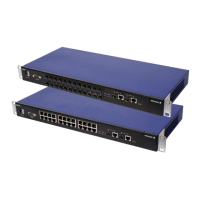Glossary
Incoming packet Switch decisions
VLAN ID equal to 2, destination
address C.
Forwarded to switching domain 3.
Switching domain 3 floods the
packet to both port 7 and to port 9.
The VLAN Tag is untouched
(‘transparent’).
The last row in Table 5 is an example of flooding. Flooding may occur when a
switching rule is set to ‘normal’. If forced forwarding is configured, flooding is
restricted.
Note that switching domain number is the number of the switch domain object.
Do not confuse this with the VLAN ID located inside the VLAN Tag.
At configuration, when specifying connections in the CLI, the EFN324 checks
the consistency of the latest command against the commands issued earlier.
The command is rejected if inconsistencies are found. Therefore, an actual
configuration is always correct from the switching logic point of view. It is up to
the operator to ensure that it is also correct from a traffic point of view.
7.2 The Connect Command
The previous section gave the basis for defining connections through the
EFN324 switch. A connection is defined using a connect command, which
targets the resource object types ethernet_port and vlan. In addition, the flows
within each connection are assigned.
Note that the resource object type connection is not directly involved. The
connection object may be seen as a container of additional attributes, which
specify how IP validation, multicast and Option 82 are handled on the
connection in question.
The syntax of the connect command is:
# connect vlan M (1 – 200) ethernet_port N (1 – 26) OPTIONAL
PARTS
The optional parts are:
ingress followed by a sub-set of the following:
Attribute Description
bandwidth_limitation Specifies bandwidth limitation at ingress.

